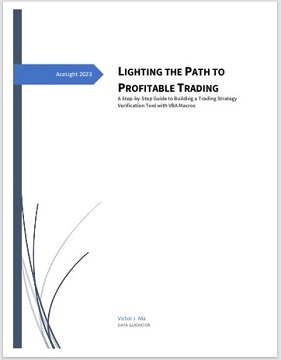Mastering Price Action Trading:
A Simple and Effective Strategy for Stock Traders
|
|
Have you ever wondered why stock trading seems like a mysterious and complex
game, with the market gyrating up and down like a rollercoaster on steroids?
If you're feeling overwhelmed and confused, don't worry – you're not alone.
Even some of the most experienced traders occasionally feel like they're
playing a high-stakes game of poker with a deck of cards that keeps
changing. Here, we're going to demystify the art of stock trading and
introduce you to the exciting world of price action trading – without
resorting to complicated technical jargon or mind-bending mathematics. So
grab a cup of coffee (or a stiff drink, depending on your risk tolerance),
sit back, and let's dive in!
Stock trading can be a profitable
venture if done correctly. One of the essential tools in the arsenal of a
successful trader is the use of price action strategy. This strategy focuses
on analyzing the price movements of stocks, rather than relying solely on
technical indicators or fundamental analysis. In this blog, we will discuss
what price action trading is, its benefits, and how to use it effectively in
your trades.
What is Price Action Trading?
Price action
trading is a strategy that focuses on analyzing the price movements of a
stock to make trading decisions. Traders who use price action trading
strategies are not concerned with complex indicators or algorithms. Instead,
they rely on their ability to read and interpret the movements of the stock
price and make trading decisions based on that information.
Price
action traders typically use candlestick charts to analyze price movements.
These charts display the open, high, low, and close prices of a stock over a
set period. By studying these charts, traders can identify patterns in the
price movements that may indicate the direction the stock is likely to take
in the future.
Benefits of Price Action Trading
Price action
trading has several benefits over other trading strategies. These include:
1. Simple to Understand: Price action trading is a straightforward
strategy that does not require complex technical analysis or advanced
mathematical calculations. It is an excellent choice for novice traders who
are just starting.
2. Accurate: Price action trading is based on
analyzing the actual movements of the stock price. This makes it more
accurate than other strategies that rely on technical indicators or market
trends.
3. Versatile: Price action trading can be applied to any
market, whether it is stocks, forex, or commodities. This makes it a
versatile strategy that can be used in any market condition.
4.
Profitable: Price action trading can be a profitable strategy if used
correctly. By accurately predicting price movements, traders can make
profitable trades and maximize their returns.
How to Use Price Action
Trading Strategy
Now that we understand what price action trading is
and its benefits, let us explore how to use it effectively in your trades.
1. Identify Key Levels
The first step in price action trading is
to identify the key levels of support and resistance. Support levels are the
price points at which the stock price has historically bounced back up after
a drop. Resistance levels are the price points at which the stock price has
historically stopped rising and started to fall.
By identifying these
levels, traders can determine when to buy or sell a stock. If the stock
price is approaching a support level, it may be a good time to buy.
Conversely, if the stock price is approaching a resistance level, it may be
a good time to sell.
2. Analyze Candlestick Charts
The second
step in price action trading is to analyze the candlestick charts. Traders
should look for patterns in the price movements, such as bullish or bearish
engulfing patterns, dojis, or hammer patterns.
These patterns can
indicate the direction the stock price is likely to take. For example, a
bullish engulfing pattern, where a small red candlestick is followed by a
larger green candlestick, may indicate that the stock price is likely to
rise.
3. Use Trend Lines
The third step in price action
trading is to use trend lines. Trend lines are lines drawn on the chart to
connect the highs or lows of the stock price. They can help traders identify
the direction of the trend and determine when to buy or sell a stock.
If the trend line is sloping upward, it indicates an uptrend, and
traders may want to buy. Conversely, if the trend line is sloping downward,
it indicates a downtrend, and traders may want to sell.
4. Manage
Risk
The fourth and final step in price action trading is to manage
risk. Traders should always set stop-loss orders to limit their losses if
the stock price moves against them. Stop-loss orders are an essential tool
to manage risk and protect against significant losses.
Traders should
also set profit targets to ensure they take profits at the right time.
Profit targets can be set based on the support and resistance levels
identified earlier, or based on other factors such as technical indicators
or market conditions.
It is also important for traders to have a
solid understanding of risk management principles. Traders should never risk
more than they can afford to lose and should always have a plan in place to
exit a trade if things are not going as expected.
 The
most important part is the TEST. Without proper testing processes, including
back-testing and forward-testing, even the most famous trading strategies
may not be suitable for all investors. A trading strategy that works well
for one investor may turn out to be a disaster for another. Therefore,
investors need to do their homework before investing their money. The
most important part is the TEST. Without proper testing processes, including
back-testing and forward-testing, even the most famous trading strategies
may not be suitable for all investors. A trading strategy that works well
for one investor may turn out to be a disaster for another. Therefore,
investors need to do their homework before investing their money.
The
testing process involves analyzing historical data to evaluate the
effectiveness of a trading strategy. Back-testing involves analyzing past
data to identify whether a trading strategy would have been profitable.
Forward-testing involves applying the trading strategy to current market
conditions to evaluate its effectiveness.
For more details, click
LIGHTING THE PATH TO PROFITABLE TRADING: A Step-by-Step Guide to Building a Trading Strategy Verification Tool with VBA Macros to get the whole tutorial handbook for free!
And click Free Trial to download other strategies testing tools, all for a 30-day Free Trial.
Click on Subscription to order more strategies testing tools to help your stock trading.
Examples of Price Action Trading Strategies
Here are a few
examples of price action trading strategies that traders can use:
1.
Breakout Strategy
The breakout strategy is a popular price action
trading strategy that involves buying a stock when it breaks through a key
resistance level or selling when it breaks through a key support level.
Traders should wait for the breakout to occur and then enter the trade.
For example, if a stock has been trading in a range of $50 to $60 for
several weeks, and then suddenly breaks through the $60 resistance level,
traders may want to buy the stock in anticipation of an upward trend.
2. Pullback Strategy
The pullback strategy involves waiting for a
stock price to pull back after a significant move in the opposite direction
before entering a trade. Traders should wait for the pullback to occur and
then enter the trade.
For example, if a stock has been trending
upwards for several weeks, and then suddenly experiences a pullback, traders
may want to buy the stock in anticipation of a continuation of the upward
trend.
3. Reversal Strategy
The reversal strategy involves
buying a stock when it has reached a key support level and is likely to
reverse its downward trend or selling a stock when it has reached a key
resistance level and is likely to reverse its upward trend.
For
example, if a stock has been trending downward for several weeks and has
reached a key support level, traders may want to buy the stock in
anticipation of a reversal of the downward trend.
Congratulations,
you have successfully navigated the murky waters of stock trading and
emerged with a newfound appreciation for the power of price action trading.
From analyzing candlestick charts to identifying key support and resistance
levels, you now possess the tools to make informed trading decisions like a
seasoned pro. But before you dive headfirst into the world of stock trading,
remember that there are no guarantees in the market – except, of course, for
the fact that Murphy's Law always seems to be lurking just around the
corner. So, as you embark on your trading journey, always remember to keep a
sense of humor, a level head, and a well-stocked supply of antacids on hand.
Happy trading!
|


|

Free Tutorial
Share
|
|
|
|